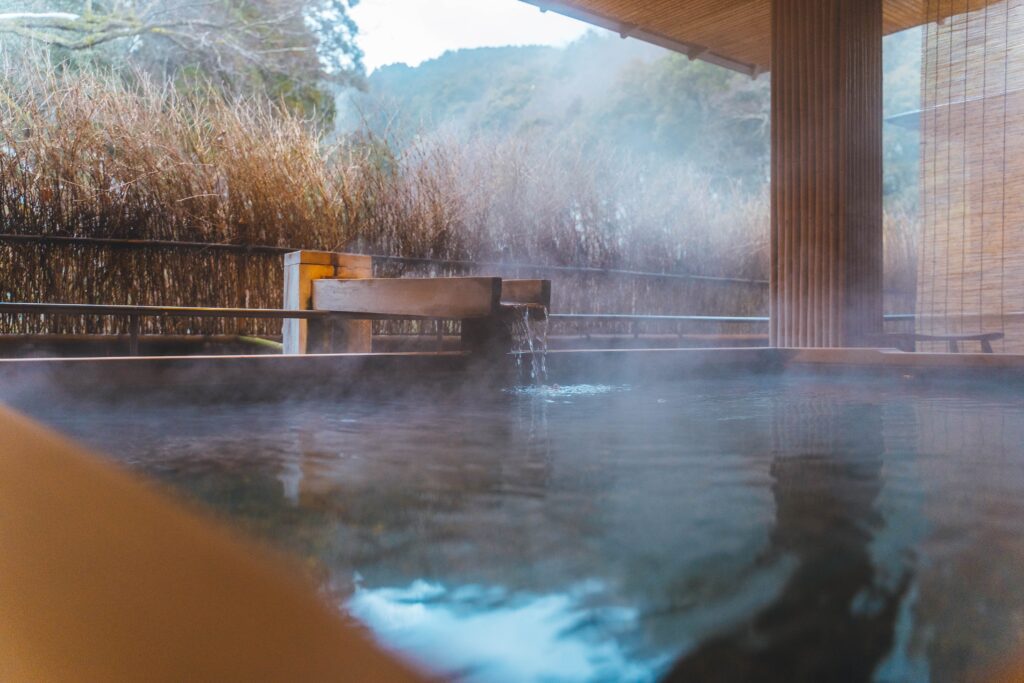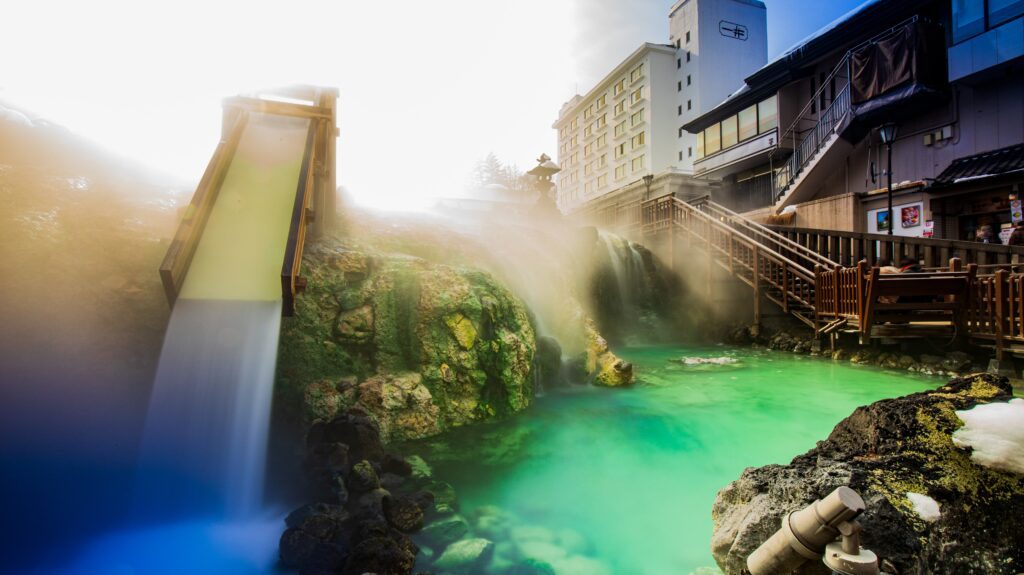Recently updated on February 20th, 2025 at 03:26 pm
A Japanese onsen is a must-visit when traveling through the land of the rising sun. These are traditional Japanese hot spring baths, known for its healing properties and soothing stillness. These geothermally heated springs are typically nestled in picturesque settings, such as mountains, forests, or coastal areas. The unique combination of mineral-rich thermal waters and serene surroundings makes onsen bathing a cherished practice in Japanese culture. In fact, taking a dip in an onsen is like taking a dip in Japan’s history, with onsen mentioned in the Nihon Shoki, one of Japan’s oldest books. There is evidence that onsen may have been used up to 3,000 years ago! And with a long, rich culture, comes a certain etiquette. Before you take the plunge into the world of onsen, it’s essential to know the ins and outs of this timeless tradition ahead of your trip to Japan.
We think you may also like: Here’s what you’ll find on the 7 most magical Japanese islands
Types of Japanese onsen


While there are thousands of onsen throughout Japan, they can be broadly categorized into a few main types. All of them have to adhere to certain criteria for them to be considered an onsen
There are certain criteria that make an onsen. First, they need to be natural hot springs, either naturally or from artificially bored holes. The hot spring water needs to be above 77°F (25°C), and it must hold at least 1 of 19 different kinds of minerals. From here, the onsen start to differ. You may even see several different types within the same facility! Here are some words to look out for:
- Ryokan onsen: These are often found in traditional Japanese inns called ryokan. Ryokan onsen offer guests a complete cultural experience with tatami mat rooms, kaiseki meals, and yukata (traditional robes).
- Rotenburo: These are open air baths, often located in nature. Most onsen will have a rotenburo, and it’s here where you get the real tranquil experience: soaking in mineral-rich waters in outdoor baths while surrounded by beautiful landscapes.
- Uchiburo: These are the indoor baths. They vary from classic old-world wooden designs, to sophisticated modern establishments.
- Konyoku: Most hot spring baths are separated by gender. However, you can still find a few mixed-gender baths, particularly in traditional and remote locations. While some of these baths follow the tradition of complete nudity, many provide the option for bathers to use towels or robes for privacy.
- Nekorobi: Not your typical bath. It involves reclining on stone slabs where naturally hot water gently flows. You lie comfortably, often with a raised stone for a pillow, while gazing at the sky. The continuous flow of water ensures you stay warm and relaxed throughout the experience.
- Hinoki: Look out for onsen crafted by hinoki, a cypress tree that originates from Japan. This wood is prized for its natural resistance to decay and its delightful lemony fragrance.
There’s a whole world of onsen we haven’t mentioned, otherwise the list would be too long. From mineral-specific baths, like sulphur and hydrogen onsen, to sand baths (sunaburo), steam baths (mushiburo), and more.
Onsen Etiquette


Going to an onsen is a cultural experience going back thousands of years, which means there’s a certain etiquette. Make sure you follow these rules and show the locals the same respect they’ll show you.
Nudity: In traditional Japanese culture, you bathe in the onsen naked. This is because clothing is considered dirty, and the onsen is all about purifying your body. Be prepared to disrobe before entering the hot spring. Small towels are provided for covering up while moving between pools.
No glass: As everyone is naked, no glass is allowed in the bathing area or the locker room.
Pre-Bath Ritual: Before entering the onsen, thoroughly wash your body at the designated washing area. This is in the kake-yu, which is normally the first thing you’ll see when you enter the bath. Make sure to rinse; you may be asked to leave if you enter the onsen with soap, dirt, or sweat on your body!
Do not put the towel in the water: You can’t put your wash-towel or any soap into the bathtub. This goes back to keeping the hot spring water pure.
Your head must stay above water: Again, because of germs from your mouth or chemicals from your hair. No dunking your head under water.
No running, no swimming: There is a sense of serenity and stillness here. Don’t disturb this with any running (also for safety), or swimming in the baths.
You can’t be drunk: As the onsen is really hot, you can’t drink heavily and then go take a bath. No food or drinks!
Tattoos: Visible tattoos are prohibited, because of historical connections to the yakuza (Japanese organized crime). Though, attitudes are slowly changing with the new generations. That means some onsen will accept small tattoos, but a lot won’t. It’s best to call ahead, and you can also get waterproof bandages to cover them up too. This interesting article from Japanese magazine talks about tattoos and onsen culture.
Be quiet and Respectful: In Japan, courtesy is key. Keep voices low and avoid loud behavior. Onsen bathing areas are designed for peace, relaxation and contemplation.
We think you’ll also like: 10 interesting facts about Japan’s legendary warriors – the Samurai
Best Onsen Destinations


Japan is covered with onsen of all shapes and sizes. Here are some of the country’s best spots:
Hakone: A short trip from Tokyo, Hakone is a renowned onsen bath town with stunning views of Mount Fuji.
Beppu: Located on the southern island of Kyushu, Beppu is famous for its diverse onsen types, including sand baths and mud baths.
Kinosaki: In the Kansai region, Kinosaki is a charming onsen town with a retro feel, complete with willow-lined canals and traditional ryokans.
Kotohira: This hot springs mountain village is home to the Kotohiragu Shrine, a place of worship since the Edo period. On Trafalgar’s Splendours of Japan tour, you’ll get to visit Kotohira and its incredible shrine, before staying in a traditional ryokan with its own onsen.
An onsen visit is an opportunity to embrace Japan’s culture and natural beauty while rejuvenating your body and spirit. Remember to respect the customs, and you’ll emerge from this unique experience with a deeper understanding of this timeless Japanese tradition.